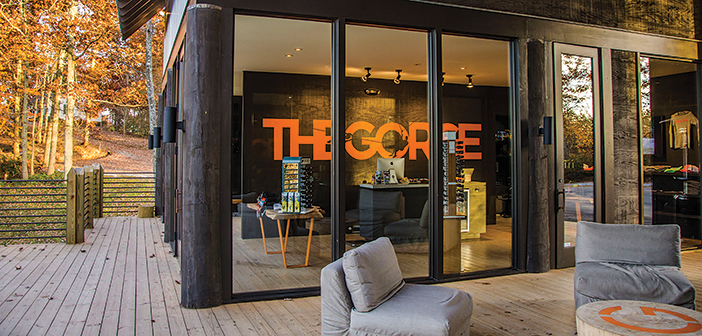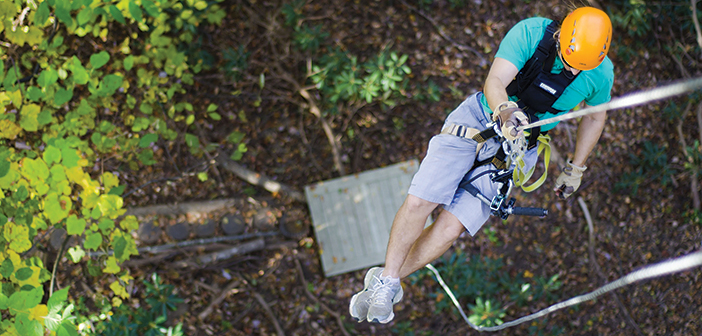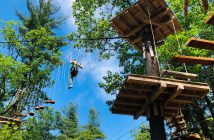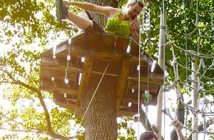Any project always takes more time and energy than expected. When it comes to developing a zip tour or aerial adventure course, which requires a good many steps, there are almost countless ways this truism applies. Detailed planning, though, can minimize the surprises and disruptions. It’s always what you don’t know you don’t know that causes problems.
I learned all this from the experience of developing a park from scratch seven years ago, with no previous experience. I was fortunate to have 44 acres near Highlands, N.C. I was also fortunate to find a great builder in Challenge Towers. I made many false starts—thankfully, none of them critical. I hope the information provided here helps you avoid making the same missteps.
When I told my wife of my idea to develop a zip tour, she asked about the financial potential. I shrugged and said, “It’s too late for us to be rich.” She replied, “But it’s not too late for us to be poor.”
Do the right things for the right reasons, and financial success will follow.
So let’s look at the process carefully. The development of a park, or the revision or expansion of one, goes something like this:
- Visit several existing parks to see if an aerial park is really your passion.
- Conduct a market feasibility study for your area, including zoning restrictions.
- Secure land and financing, if needed.
- Host a minimum of three site visits by ACCT approved contractors.
- Select the design and builder of your choice and sign a contract.
- Sit back and wait for opening day. (Wouldn’t that be nice?)
There are a still more hurdles to overcome after you sign the builder’s contract, though. A good builder excels at his or her craft, but your to-do list is far from complete. Regardless of the scope of your project, a surprise “must do” seems to appear each day. Don’t waste one moment of time between the signing of the contract and opening day.
Permits, Licenses, and Inspections
While it is impossible to list chronologically the chores ahead, let’s start with a few basics. In the development process, we know there will be land disturbance, water runoff, grading, silt retention, culverts, bridges, and other “earth” issues. To deal with these, plan to hire and retain a geologist or environmental engineer. An unanticipated expense? This will be the first of many, but well worth the extra trouble as you negotiate the morass of permits. After all, you want to protect the environment, or you wouldn’t be in this business. So don’t take any shortcuts at the expense of the ecosystem.
You will need to complete applications for environmental, construction, safety, regulatory, and local ordinances. This may involve architects, geologists, engineers, and a variety of trade contractors in addition to your course builder. Obtain cost estimates and determine what must be done prior to your builder’s arrival. Coordinate this work to eliminate delays in which one specialist waits for another.
Visitor Center
Your visitor center is a crucial piece of the overall park, and is the hub of all non-course activity. Carefully plan the space to handle peak customer flow and comfort, but do so as cost-efficiently as possible. The space should also be visually appealing. And remember, it’s a multi-purpose building: it will also house your business office and staff space.

It requires thorough planning to design a quality, functional visitor center.
Having too much space is expensive, but having too little is devastating.
Putting It All Together
You, the builder, and the electrician must coordinate to craft the most efficient and aesthetically appealing layout you can. There are a lot of needs to balance. Among them:
The public area serves several key functions. It handles guest check-in and checkout, provides restrooms and waiting accommodations, and showcases your retail merchandise. Plenty of space for guests and staff to gear up and gear down will be needed.
Traffic flow from one procedure to the next is an important aspect of planning. Prevent bottlenecks by providing separate decks, picnic tables, game spaces, and comfortable waiting areas to draw guests away from the main facility. Guests like to gather before and after the experience, so a food and beverage space, covered deck, or picnic area with a fire pit are good options. These spaces also accommodate guests who do not participate in the aerial park; they need a comfortable space to watch and wait for friends and family.
Consider your employees’ needs, too. These include a break room, office space, and lockers. Provide an area where the employees can store, rotate, and dry their gear. Prevent mice and other pests from accessing this space or the guests’ area. Then there’s all your equipment, which needs space for storage and, in many cases, cleaning and drying.
Have a convenient space provided for vehicles, tools, and storage, either as part of the center or in a separate building.
Adequate parking for both guests and staff with adherence to ADA requirements is essential.

Have plenty of parking for staff and guests, and make sure it’s ADA compliant.
Whether you build your center from the ground up or adapt an existing facility, there will be permits required and inspections to schedule. Before construction can begin, you need to submit and gain approval for your architectural plans. Among the many permits you may need: foundation, well and septic, electric, plumbing, and ADA parking. There could be other, local issues to address.
You need wiring for everything. This may include Wi-Fi, landlines, computers, credit card recorders, reservations software, TVs, satellite or cable television, security systems, fire monitors, heaters, dryers, dehumidifiers, hot water heaters, and exterior power. Pay close attention to the location of electrical outlets, wall switches, and lighting, and make sure your breaker box and service are up to the task of managing the entire system.
A System of Systems
You have several decisions to make regarding communications and office systems, so commit plenty of time and energy into the task.
A facility-wide radio communication system is essential. Since the system would be beneficial during course construction, install it prior to the builder’s arrival. A wired system is more reliable than walkie-talkies, so take that route if possible. UHF radios with a repeater install for about $5,000, which is money well spent. You need to be able to communicate clearly, especially during an emergency.

In the air or on the ground, a reliable radio comm system is essential.
Signage, fencing and other permanent or temporary precautions should be set where appropriate.
The daily course, gear, and grounds inspection protocols should be developed and implemented, with proper record retention. Be alert to additional safety concerns as they arise.
Weather tracking and lightning detection systems are also essential for operations at height. Your builder will appreciate having these systems operational during construction. There are a variety of useful, inexpensive weather and radar apps you can use, but these merely complement—not replace—a comprehensive system, which might cost upwards of several thousand dollars.
Office systems will require Wi-Fi and adequate—i.e., extensive—wiring. A reservations system is imperative. Plot out the variety of office equipment you need, and position it for maximum efficiency. This must be determined prior to installation of electrical and phone lines.
Accounting procedures must be in place prior to office staff training. Plan for record retention and recognize the magnitude of records you must maintain. Give serious consideration to electronic record-keeping.
Staff management systems are another high-priority item. Scheduling procedures, compensation plans, payroll, personnel files, required accreditations, training, evaluations, and employee manuals all need to be in place prior to hiring anyone.
Weekly staff scheduling is a time-consuming and inexact science. Part-time and seasonal staff deserve a schedule at least 10 days in advance, so they can make their own plans. It can be a challenge to establish a scheduling system and payroll tracking, so get started on this planning sooner rather than later.
Payroll must be on time, accurate, and explainable. It’s complicated, but there are many products designed to make it easier for you. Don’t skimp on this. If timely payroll becomes an issue, you’ll lose credibility with your workforce.
If you have an existing accounting department, the addition of the park should be relatively simple. QuickBooks or a similar service is sufficient if kept current each day. If you perform accounting in-house, you may want to use a monthly service for tax preparation.
Your reservation system/software is a vital aspect of your operation. It is important to research carefully and select which software will best suit your needs—there are dozens available for our industry. (Ed. note: This magazine reviews reservation and recordkeeping software regularly.)
Equipment
For a typical adventure park, budget at least $50,000 for vehicles and additional gear. You will likely have ATVs or other means of transport, and a small tractor with a front-end loader for trail and parking lot maintenance.

Gear up, gear down, and equipment storage areas need to be carefully planned for.
You may well need a variety of other equipment to maintain your courses and grounds. Gasoline chainsaw, blowers, portable generator, weed eater, electric air compressor, and a complete tool set including torque wrench, shovels, rakes, and fuel cans are typical. (For some tips on what tools to have, see “My Favorite Maintenance Tools”)
You will also need an array of cleaning supplies, paper products, and dispensers for interior areas. Check with your builder about the need for a heavy-duty cable puller and other course-specific equipment.
All the Rest
For the inexperienced operator, insurance is a formidable concern. It shouldn’t be—aside from the cost, that is. If you attend to the details of proper course construction and design, getting insurance should be simple. We are fortunate to have professional agents familiar with our industry, who can advise about workers’ compensation, comprehensive, and various classes of liability. (For more on insurance, see “Getting the Most From Your Insurer)
Make sure that any subcontractor you might hire for day labor—the arborist who prunes limbs, the local mulch guys, the kid who weed-eats the driveway—has coverage, or understand that they will be covered by your plan. A certificate of insurance for all possibilities is necessary. Don’t risk a dollar to save a dime.
For staffing, there are four general classifications of jobs: management, tour guide, office staff, and maintenance. It is very important to cross-train staff where possible. Having a bunch of versatile employees is invaluable.
The Adventure Park Insider “State of the Industry Report” shows that finding staff is the biggest concern operators confront. Still, the talent pool consists of a wide range of possible employees: college students, educators, military retirees, off-season guides from other attractions, first responders with a few days off, nighttime hospitality workers. The key traits they need are a pleasant smile, positive attitude, cleanliness, and enthusiasm. You can train for the necessary skills.
Before hiring, perform background checks and, if you prefer, administer a drug test.
Training is an ongoing process that can be done by a third party, in-house, or a combination of the two. Your insurer may discount your premium if you use third-party trainers. If so, this can offset the expense.
Often, trainees are not placed on payroll until they have completed training and qualified for hiring—check with your state regulations regarding this. However, once they are on payroll, compensating your employees for required training is a must.
Marketing may be last on this list, but it’s one of most important things you’ll do. The first step is to create a name, logo, and color scheme to be used consistently throughout all advertising. This helps establish the park’s brand. The next step is to make sure all possible guests hear about you by placing ads on various marketing channels. Marketing can be done in-house, or with the help of an agency.
(Ed. note: You can learn more about marketing options in the Adventure Park Insider “State of the Industry Report” and the “Insider Marketing” columns at adventureparkinsider.com/api-online.)






